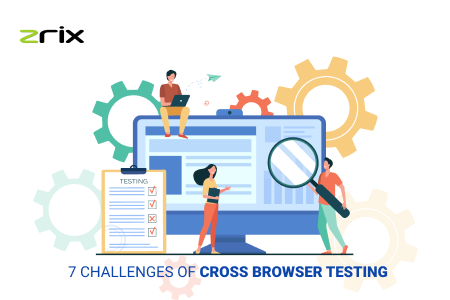7 Challenges Of Cross-Browser Testing

With the quick progressions in digitization, businesses endeavor to guarantee their web app moves along as planned on all browsers. The present businesses depend on the internet presence to build their ROI and extend their online reach.
This is the motivation behind web applications to be compatible with multiple browsers. It implies that the application should be compatible with each browser version at any time.
Regardless, cross-browser testing is something that has been neglected, though has many challenges of cross-browser testing automation.
We will investigate some cross-browser testing issues and browser compatibility testing challenges in this blog post!
Quick Navigation
- Why Cross-browser Testing Is Important
- Top Cross Browser Testing Challenges
- Discovering Layout Issues During Automation
- Color Rendering
- Testing is Time-consuming
- Testing Different Version of Browsers in Different Platforms
- Multiple Languages Unicode
- Regular Updates and Releases
- Testing for Visual Bugs in all Screen Resolutions
- Final Words: Solve Cross-browser Compatibility Issues!
In straightforward terms, cross-browser testing means guaranteeing a uniform web application's functionality across various browsers, browser versions, and operating systems while providing an issue-free user experience to its users.
Cross-browser testing includes a blend of browsers and operating systems to test the application's responsiveness and compatibility. The idea of cross-browser testing is clear yet can be precarious.
With technology, you can begin testing your application in the local organizing environment before moving it to creation. Nonetheless, with cross-browser testing, you can track and fix bugs even after sending them underway.
Why Cross-browser Testing Is Important?
In case you are intending to do ordinary functional testing in various browsers. Then, at that point, it isn't essential to do cross-browser testing. It's simply excess work. In a perfect world, you should test most of your business logic in the unit while joining different levels of testing.
Later in UI, you will concentrate for the most part on start to finish situations via Automated or manual. At last, cross-browser testing is about the consistent rendering of data across all browsers. A browser extension development company would essentially test for page layouts, bogus up-sides in images, and localization data.
Therefore, here are a few challenges you may face and we have recorded the conceivable arrangement known to our knowledge. Furthermore, this is regardless of whether you will test manual/automated.
Top Cross Browser Testing Challenges!
The browser fight is an unending aggravation for the web application developers who have the responsibility to satisfy the client with the much compatibility as could be expected.
So on the off chance that you have five top browsers, suppose, Chrome, IE, Edge, Safari, and Firefox, you'll need to test them on different OS versions also. The top challenges are as per the following:
Discovering Layout Issues During Automation
Automation scripts don't know whether your data is introduced appropriately. However, it has the data on the website, it will push ahead. In any event, during manual testing, there are situations of bogus up-sides. The application may look wonderful in your screen resolution; however, the layout may experience different resolutions which you can't get.
The arrangement is to use Automated visual approval with cross-browser testing tools like Applitools/Sikuli. It can precisely recognize the layout changes which are even imperceptible to people.
Color Rendering
Sometimes browsers dependent on the platform may render Colors contrastingly or minutely. So with natural eyes, you will not remember it. However, sometimes that may wind up disastrously especially with retail websites.
An end-user may be misinformed by the look and feel. You can do careful bitmap approval for every page across browsers which will precisely discover what's turning out badly. The UX designs then will sort out an approach to fix it utilizing a cross-browser testing platform.
Also Read: 7 Ways to Fix Unwanted Sites Open Automatically In Google Chrome
Testing is Time-consuming
Every one of the endeavors that have been made to automate cross-browser testing isn't yet sufficient. There are arrangements like BrowserStage and Selenium to automate a couple of parts of the applications we construct. However, no one can tell when a minor, unimportant issue turns into a threat for the client.
We say this with experience. Firefox has once rendered a website that our team constructed useless when another redid version came out. It was possibly discovered when we saw a high bounce rate from a segment of users.
Testing Different Version of Browsers in Different Platforms
This is a major aggravation when you are focusing on a gigantic arrangement of individuals chipping away at a variety of browsers. Preferably, the developers should remember this and develop the application as ideal as could be expected. Yet, it is practically conceivable to test every unique browser.
Provided you have such business need to do it. Then, at that point, You can use the force of cloud-like BrowserStack where you get each unique sort of browser in a flick of a second.
Multiple Languages Unicode
If you happen to introduce multiple languages on your website you need to ensure every one of the significant browsers renders it effectively. Again doing this manual is a lumbering position and it is inclined to many human errors. So use visual approval alongside the force of cloud-based testing of browsers.
Regular Updates and Releases
Browser creators incline to give out the latest components to everybody. This implies another browser version like clockwork and which additionally implies, 280 new bugs every year. For somebody who is taking care of multiple web application projects, this is a tremendous errand to satisfy.
Testing for Visual Bugs in all Screen Resolutions
Testing your site for visual errors manually can hoard up a ton of time. It's not new information, and our brain goes directly to test automation. However, note that distinguishing broken layouts for sites and web apps utilizing test automation can be somewhat precarious.
Also Read: How Firefox's Android App Gives Better Experience With Desktop Features
For this situation, there is a ton to manage, particularly when we start to count the distinctive test environments. Simply, we add mobile devices with their arrangement of browsers, the rundown could never be finishing. A cross-browser testing app or a tool ought to guarantee consistent UI testing in all screen resolutions.
"Normal Browser Compatibility Issues: Incorrect DOCTYPE, Lack of a Valid HTML/CSS, No CSS Reset, Vendor-Specific CSS Styles, Outdated and Older Browser-Detection Scripts, JavaScript Failure to Detect Browser, and Layout Compatibility Issue."
Final Words: Solve Cross-browser Compatibility Issues!
The application performance is a fundamental basis to decide the general accomplishment of the web application and the business. In any case, numerous developers wrongly believe that application performance just incorporates the user interface functioning.
In the current Generation, new operating systems, browsers, and devices are being acquainted with the market pretty much every day. The developers should guarantee that the application holds stable performance on these new platforms.
Each responsive web design services provider thinks that cross-browser compatibility testing is the last advance of web application development. The developers for sure need to confront different challenges while performing cross-browser testing.
Be that as it may, with a little devotion, development, and work experience they can undoubtedly conquer these obstructions. What are your thoughts?












